Text
#MiniatureMonday
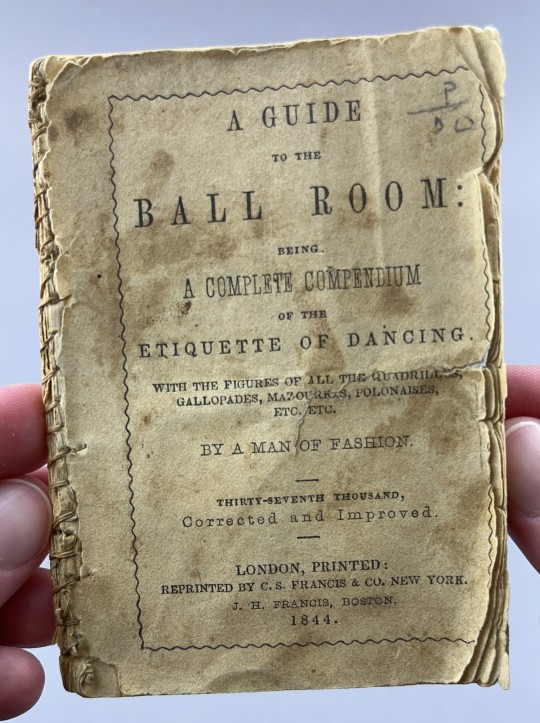



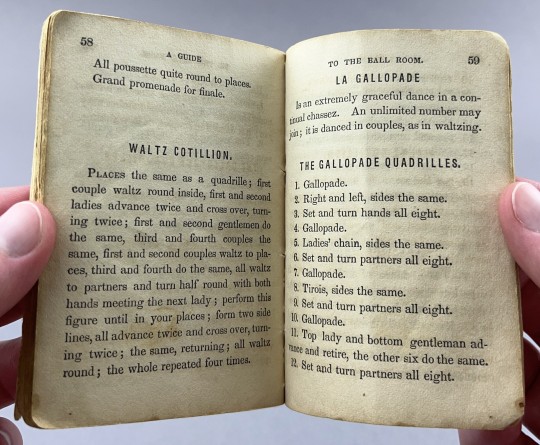
A guide to the ball room : being a complete compendium of the etiquette of dancing : with the figures of all the quadrilles, gallopades, mazourkas, polonaises, etc., etc., beautifully embellished / by a man of fashion.
A guide to the ball room is a stunning little book dated all the way back to 1884. Detailing many etiquette and dancing rules, along with instructions, this book is a perfect guide to learning the ins and outs of the ball room.
The back of the book also features a glossary of French terms often used in the ball room. So grab a partner, read this book, and get to dancing--just like those from the 1800s!
--Adair J.
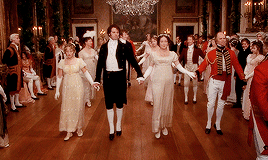
#libraries#uiowa#special collections#miniaturemonday#rare books#dancing#ballroom#miniature books#etiquette#gif
86 notes
·
View notes
Text

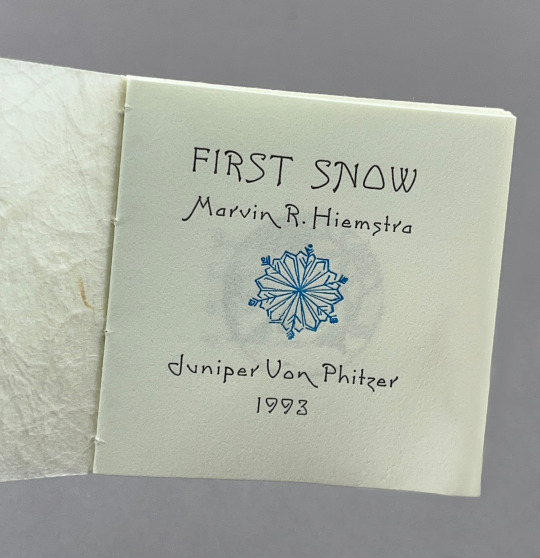




#MiniatureMonday
First Snow / Marvin R. Hiemstra.
First Snow is a beautifully bound book published in 1993, made with a Japanese binding technique that was first created during the Heian period (794-1185 CE). Originally published as part of a four-season series, this poetry book contains several delightful poems with stunning artwork that aides the story wonderfully!
-- Adair J.
54 notes
·
View notes
Text
#MiniatureMonday
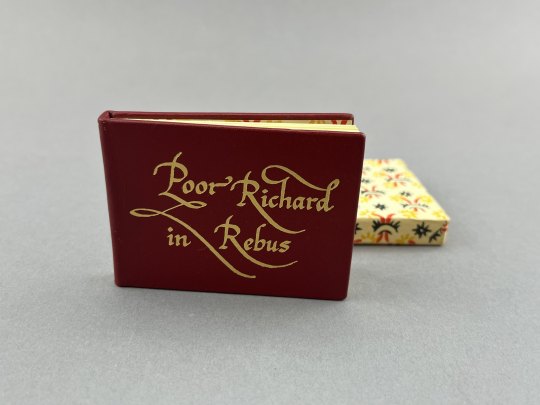

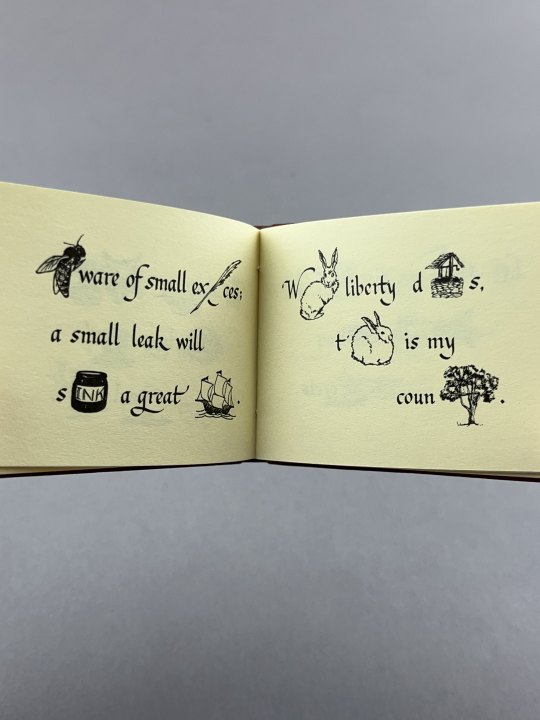

Poor Richard in Rebus: selections from Poor Richard's Almanack // by Benjamin Franklin; introduction by J. Michael Lennon
Poor Richard in Rebus contains a series of visual riddles, where images are used in place of some parts of words. Rebuses have been around since the Middle Ages, where they were often associated with heraldic expressions.
Do the pictures above stump you? Don't worry, the back of the book contains an answer key to these riddles.
This miniature book is the perfect match for anyone who liked to watch the late 1980's game show Classic Concentration!
--Adair J
#uiowa#libraries#special collections#miniaturemonday#rare books#rebus#pictograms#almanac#benjamin franklin#word games
51 notes
·
View notes
Text
#MiniatureMonday




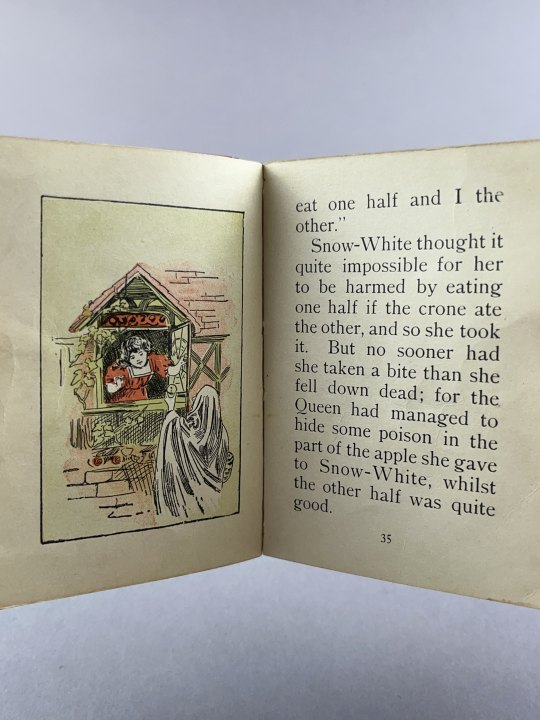

Fairy Tales From Grimm / by Jacob and Wilhelm Grimm with introduction from L. Frank Baum
The Fairy Tales from Grimm is a collection of children's stories written by the Grimm brothers, many of which have been popularized by Disney. This miniature book includes several stories such as the tale of Snow White.
Although the stories were originally published in the 1800s, this copy was produced in 1905. What makes it fantastic is the illustrations in both color and black and white. These drawings beautifully help bring the stories to life.
--Adair J.
#uiowa#libraries#special collections#miniaturemonday#rare books#miniature books#fairy tales#library#grimm brothers#l. frank baum
126 notes
·
View notes
Text
#MiniatureMonday #TinyTuesday
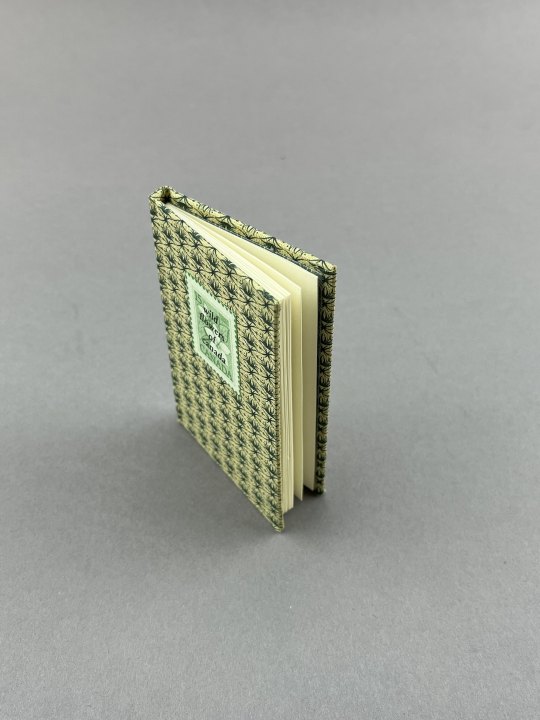


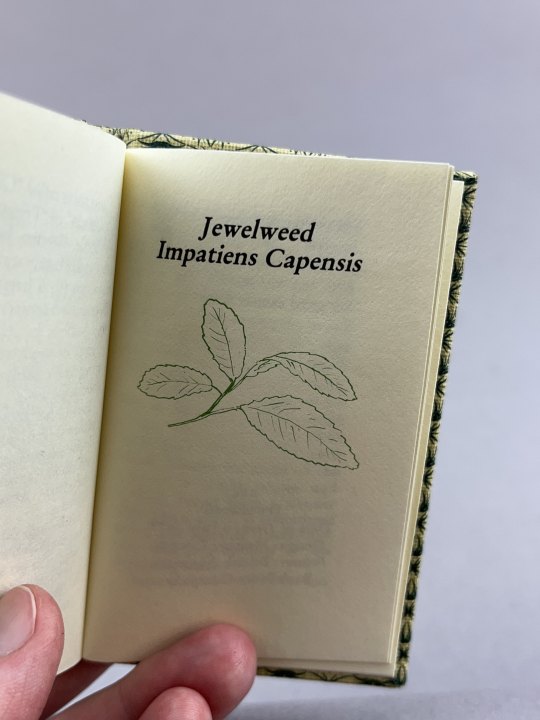
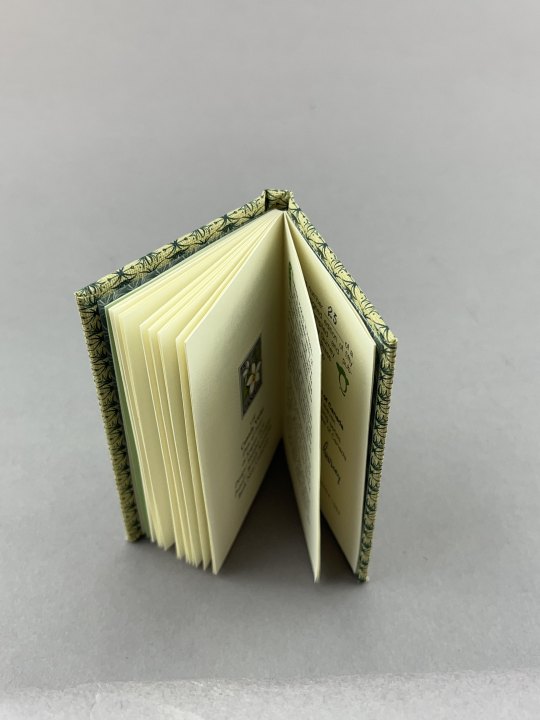

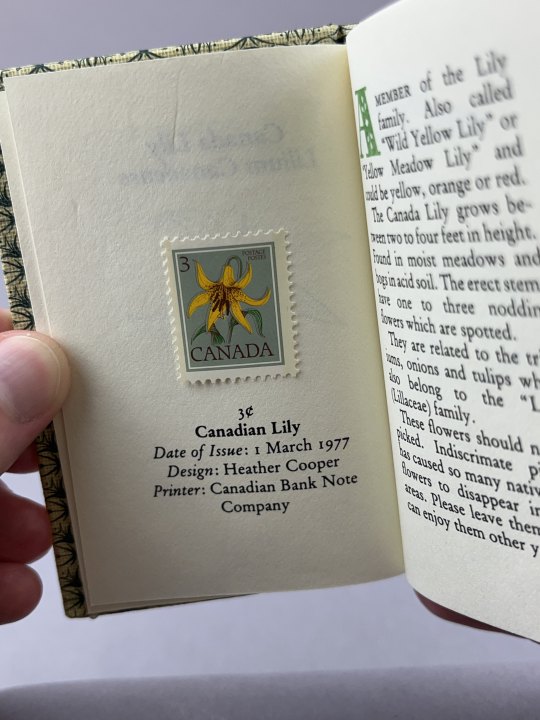
Wild Flowers of Canada / by Colin E. Roseblade
Wild Flowers of Canada is a beautiful miniature book featuring postage stamps and information surrounding Canadian flowers. Created in 1982, this 41 page book shares great insight into the history and significance of these flowers in Canada.
The included flower stamps are actual postage stamps that have been adhered to the pages. This miniature showcases many exquisite flowers, which helps to make this book a perfect read for the upcoming spring!
--Adair J.
#uiowa#libraries#special collections#miniaturemonday#rare books#stamps#flowers#miniature books#library#colin roseblade
56 notes
·
View notes
Text
#VoicesFromTheStacks

Image: Self Portrait with cranes from Hope Project (Photo credit: Clarissa Sligh)
The Artist Books of Clarissa Sligh
In honor of Black History Month, we are highlighting artist, writer, and lecturer Clarissa Sligh. Born in Washington, D.C. and raised in Virginia, Sligh is often inspired by cultural, historical, and political events that intersect with moments in her life. Sligh considers these interactions, or “collisions,” between moments in history and events in one’s life to be significant and transformative. One such example of this is detailed in Sligh’s work “It Wasn’t Little Rock,” which discusses desegregation in public schools during the 1960s, a personal topic for Sligh, who was the lead plaintiff at the age of 15 in a school desegregation case.
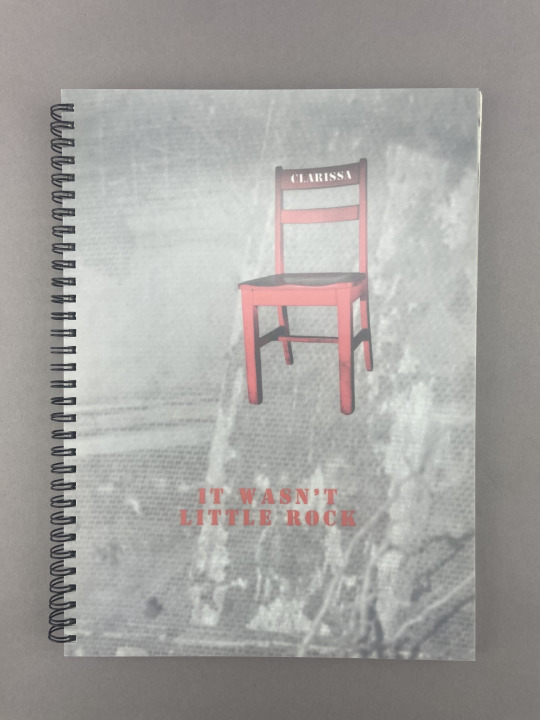
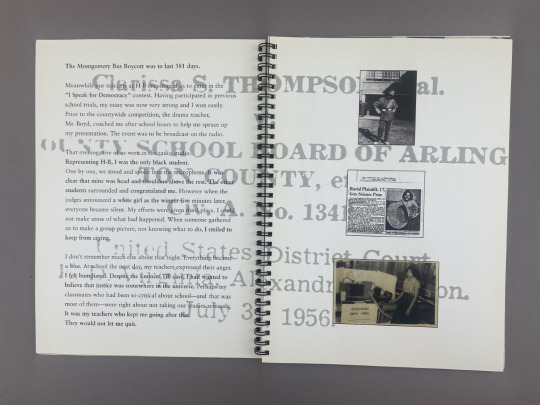
Images: Cover and inside page of "It Wasn't Little Rock" (2005)
A notable example of Sligh’s work and its reference to her personal experiences is her 1988 artist's book titled “What’s Happening with Momma?” Here, the artist engages users to “walk” through rooms of her childhood home, following the steps of accordion-folded strips of paper filled with text detailing memories of her sister’s birth in the home. This is Sligh’s first artist’s book, made through the Women’s Studio Workshop in New York.



Images: Cover and inside page of "What's Happening with Momma" (1988)
Sligh earned a BS in Mathematics from Hampton Institute in Virginia, a BFA and an MFA in visual arts from Howard University, and an MBA from the University of Pennsylvania. Earlier in her career she had worked at NASA in the manned space flight program, eventually leaving to focus on working as an artist. Her works have been featured all over the world, notably at the Museum of Modern Art in New York, the National Museum of African American History and Culture, and more. To learn more about Sligh and her works, visit the artist’s website.
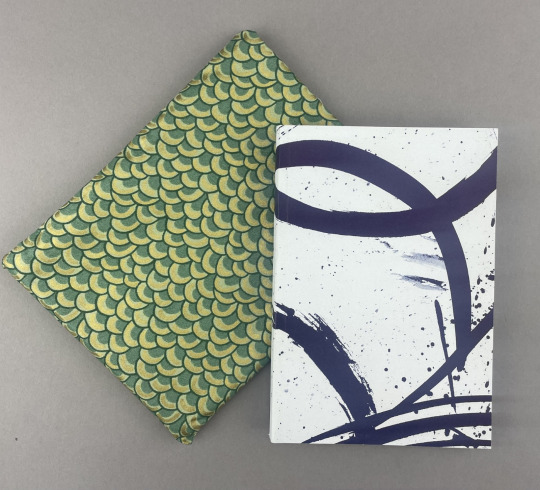

Images: Cloth enclosure, cover and inside page of "Voyage(r): A Tourist Map to Japan" (2000)


Images: Left: Inside page of "Reading Dick and Jane with Me" (1989). Right: Cover and origami crane for "Transforming Hate" (2016).
– Kaylee S., Special Collections Olson Graduate Assistant
#uiowa#libraries#special collections#uiowaspecialcollections#rare books#voicesfromthestacks#artist books#Clarissa Sligh#black history month
64 notes
·
View notes
Text
#MiniatureMonday


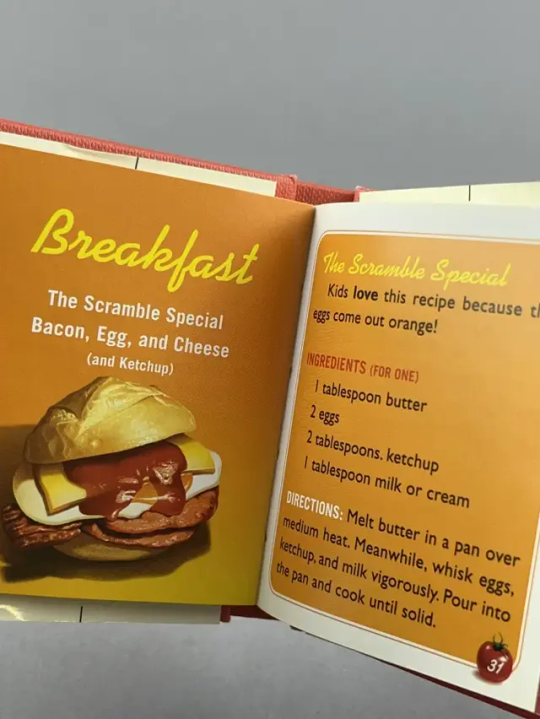


The Mini Ketchup Cookbook / By Cameron Pearl
The Mini Ketchup Cookbook is filled with recipes, artwork, and fun facts, all centered around ketchup! This miniature book was published in 2006 by the Running Press Miniature Edition, and stands at only 84 mm tall.
Regardless of how you eat your ketchup; on sandwiches, with French fries, or on hot dogs, this book is perfect reading for everyone (especially foodies). It is a great book to appreciate art, cooking, history, and ketchup trivia!
Fun fact from the book: Former President Richard Nixon enjoyed eating ketchup on his cottage cheese.
--Adair J.
37 notes
·
View notes
Text
#VoicesFromTheStacks
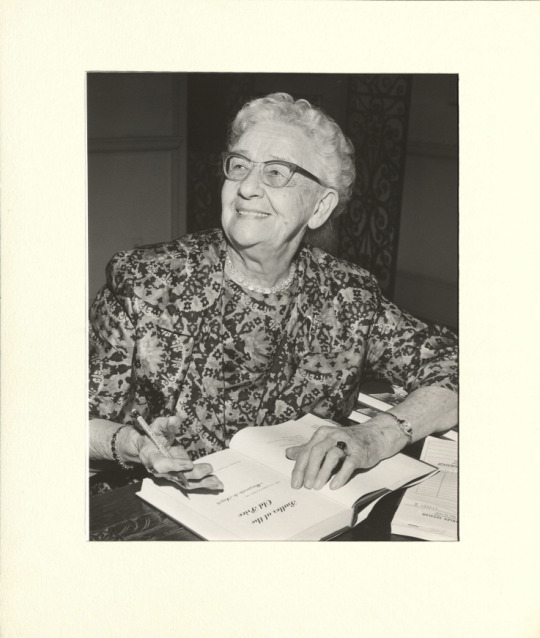
Marguerite de Angeli
Marguerite de Angeli (March 14, 1889) was an award-winning writer and illustrator of children’s books. Often inspired by her environment, many of Marguerite’s books have centered on stories from her family and childhood, and later from the lives of her children and grandchildren. These realistic scenes of families and children are what resonated most from de Angeli’s stories, with audiences finding her books to be absorbing and filled with eye-catching images.


Images: Left, Butter at the Old Price (1971) inscribed to the Wallace Family by de Angeli. Invitation to publication celebration laid in book. Right, mock up book cover illustration given to the Wallace family (James Wallace Papers)
Though born in Michigan, Marguerite’s family moved to Philadelphia when she was 13, which she later used as the setting for many of her stories. Although Marguerite was naturally skilled in writing and illustration, this did not become an active pursuit for her until later in life when her five children were nearly grown. Stemming from the Sunday school paper Marguerite illustrated in the 1920’s, de Angeli began to center her work on a younger audience, penning her first picture book in 1935. This book and the subsequent centered on two children, Ted and Nina, as they went to a grocery store and later played together on a rainy day. Inspired by two of her own children, Marguerite’s knack for recognizing beauty in everyday scenes would stick with her throughout the rest of her stories.


Images: Left, illustration from Bright April (1946). Right, Title page and inscription to Wallace family for Bright April.
While living in Pennsylvania, Marguerite came to know the Pennsylvania Dutch and Amish communities, incorporating their customs into her stories, as seen in her first Caldecott Honor Book, Yonie Wondernose (1944), the story of a curious Amish boy. She would later write about racial divisions in her story Bright April (1946), centered on racial prejudice in a post-World War II America. In 1950, Marguerite won her first Newbery Medal for the historical novel The Door in the Wall (1949), set in the Middle Ages as the Black Death sweeps across the country. She would later receive another Caldecott Honor and Newbery Honor for her Mother Goose adaptation and the Black Fox of Lorne, respectively. Though often centering on the stories of others, one of Marguerite’s last books, Butter at the Old Price (1971), tells the story of her family and the circumstances leading to her many stories and illustrations.



Images: Left, title page to The Door in the Wall (1949). Center, illustration from The Door in the Wall. Right, illustration and inscription to Antonia Wallace from The Door in the Wall.
We have most of Marguerite de Angeli’s works in our children's book collection, many of them inscribed to James M. and Christine K. Wallace and their children. James Wallace, relative to Henry A. Wallace, 33rd vice president of the United States, became friends with Marguerite and her family, as the two likely ran into each other at some point during their time in Philadelphia. Not only are many of the novels signed to the Wallace family by Marguerite, but a good few include Christmas cards and invitations to publication celebrations. Within the James M. Wallace papers, Christmas ornaments and illustrations made by Marguerite can be found as well as newspaper clippings and photographs of Marguerite, James and Christine.


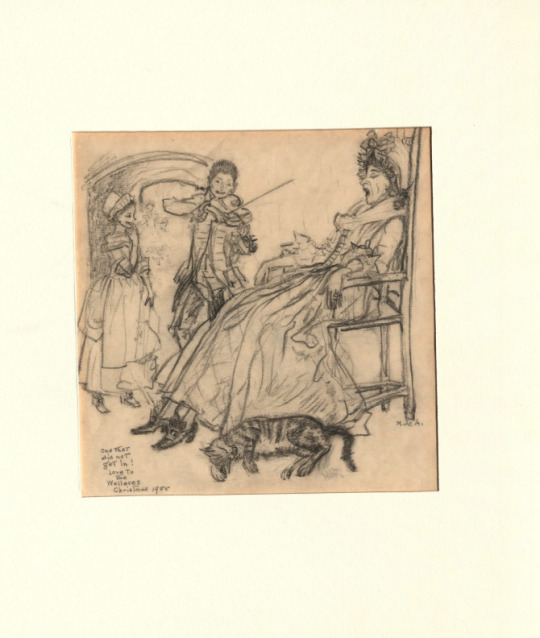
Images: Left, photo of Marguerite de Angeli, Christine and James Wallace. Center, Christmas card and ornaments made by de Angeli for Wallace family. Right, illustration that did not make it into a picture book given to Wallace family.
-- Kaylee S., Special Collections Olson Graduate Assistant
#uiowa#special collections#voicesfromthestacks#children's books#libraries#books of tumblr#Margeuerite de Angeli#women writers
30 notes
·
View notes
Text
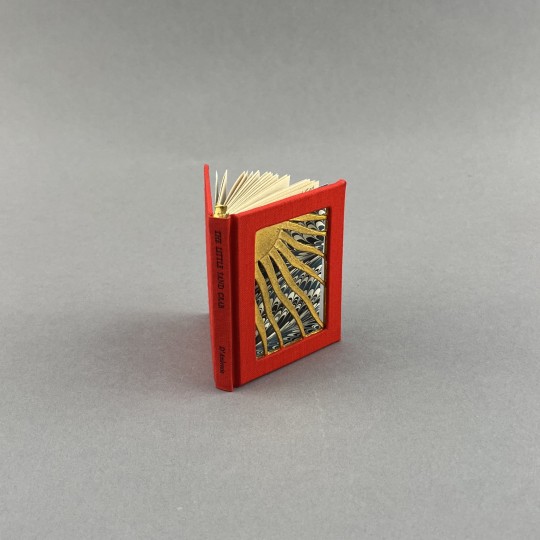

#MiniatureMonday
The Little Sand Crab/ By D'Ambrosio
The Little Sand Crab is an artist's book published in 1981 by The Compulsive Printer press. It was written, typeset, illustrated, designed, and bound by printer D'Ambrosio. The book is set in Bulmer, printed on Ingres Oyster paper, and stands at 74 mm tall. The cover is bound in red cloth and contains an openwork design of golden sun rays. UI Special Collections has copy no. 7 of a limited edition 85 copies.
This warped Princess and the Frog type tale - but with a crab of course - D'Ambrosio himself describes to be "the story of how the greed of one lover can goad the other into committing uncharacteristic acts."
--M Clark
171 notes
·
View notes
Text
#VoicesFromTheStacks

Image: Oscar Hahn from La Tercera
Oscar Hahn
Oscar Hahn, born in Iquique, Chile in 1938, began writing poetry early in life. The first book of poetry Hahn published, Esta Rosa Negra, in 1961, included poems he had written between the ages of 17 and 19. Once graduated from the University of Chile in 1963, Oscar attended the International Writing Program at the University of Iowa and received his M.A. in 1972. Upon completion of this program, Hahn returned to Chile to teach, but was arrested after the 1973 coup d'état and held in an Arica prison. Within our Oscar Hahn collection, there is a testimonial about these days in jail and their aftermath, dealing in part with how it affected him as a writer. After his release, he returned to the states and obtained a PhD from the University of Maryland, where he studied until 1977, when he returned to the University of Iowa, joining the Spanish-literature faculty.


Image: Imágenes nucleares y otros poemas by Oscar Hahn
Hahn is a celebrated, leading poet of his generation, sometimes called the Dispersed or Decimated Generation (Generacion Trilce). According to a biographical sketch in the collection, critics praised Hahn’s blend of fantastic, ironic, and realistic elements in his work, leading to the association of postmodernism and surrealism. One highlighted critical response from Kirkus Reviews contributor says Hahn “takes ordinary situations and images and implants within them a kind of surrealist grenade that explodes when least expected – and with striking effect.”
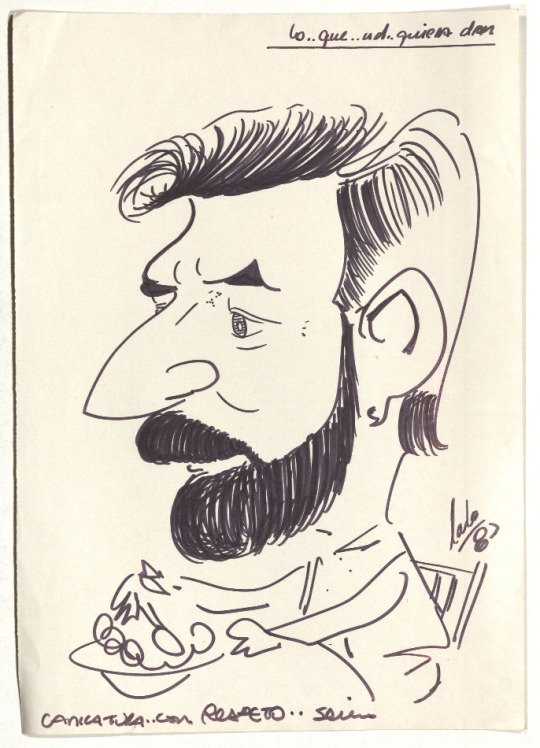
Image: Caricature drawing of Hahn from the Oscar Hahn Papers
In Special Collections and Archives, we have the Oscar Hahn Papers, containing a fairly complete list of Hahn’s publications and materials about him as well some published works in the monograph collection. A link to the collection finding aid can be found here.
-Kaylee S., Special Collections, Olson Graduate Assistant.
#uiowa#special collections#uiowaspecialcollections#voicesfromthestacks#library#poetry#chilean poetry#chile#oscar hahn
25 notes
·
View notes
Text
#MiniatureMonday

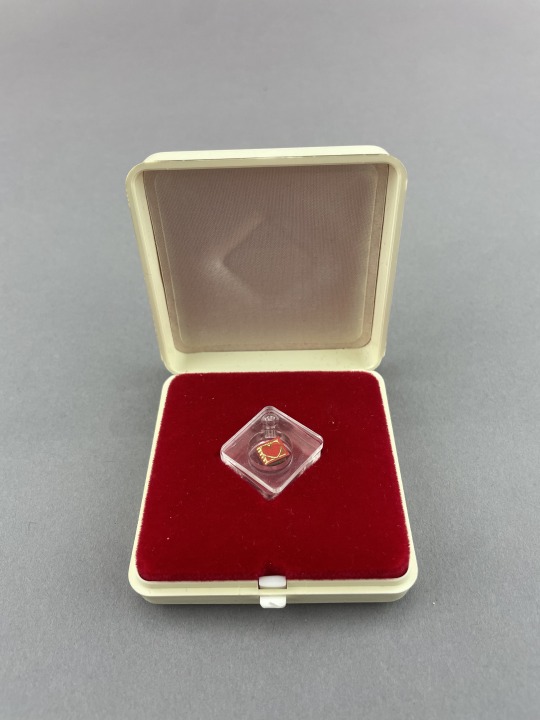

Serments d’Amour
Measuring 6mm, this micro book is one of the smallest in the collection. Serments d’Amour (roughly translating to ‘Love Oaths’), features the phrase “I Love You” in 8 different languages. The little book is bound in red leather with a stamped golden heart on the front cover, featuring golden gilded edges. The copy was issued in a cream case with a red velvet cushion and a small, magnified case to help see the finer details.
Je t'aime -- I love you -- Ich liebe Dich -- Ti voglio bene --我爱你-- Я тебя люблю-- أحبك --te amo --te quiero
#uiowa#special collections#miniaturemonday#uiowaspecialcollections#miniature books#miniature monday#French#german#italian#russian#chinese#arabic#english#spanish#microbook
200 notes
·
View notes
Text
#VoicesFromTheStacks


Images: Left, Photo of Creativity Explored community in front of entrance. Right, Creativity Explored artists Ruthie Freeland, Eddie Hippley, Michelle Kunard, and Vernon Streeter (counter clockwise from top left)
Creativity Explored
Founded in 1983 by Florence and Elias Katz, Creativity Explored, a studio-based collective in San Francisco, sought to create a space which fosters the creative expression of artists with disabilities. Creativity Explored has supported the careers of hundreds of artists since its foundation through means of training, offering supplies and resources as well as exhibition and sales opportunities. With the belief of centering the personhood and agency of the artists within the collective, the voice of disabled artists has come to the forefront through their work.



Images: Cover, inside and zines from the Whipper Snapper Nerd first edition held in UIowa Special Collections.
In 1994, two volunteers at Creativity Explored – Harrell Fletcher and Elizabeth Meyer – began collaborating on a zine series titled Whipper Snapper Nerd. Each issue of the series has been devoted to the work of one artist from Creativity Explored and includes reproductions of their work and an interview. Here in the Ruth and Marvin Sackner Archive housed in Special Collections and Archives, we are fortunate to have the first copy of a limited edition set of Whipper Snapper Nerd. Included in the collection are the first four issues of the series centered on artists Barbara Doehrman, John Patrick McKenzie, Jimmy Miles, and Michael B. Loggins. Due to the relationship Ruth and Marvin Sackner had formed with Creativity Explored, this first edition of the collection also included additional pieces from artist John McKenzie and another zine from Michael B. Loggins.
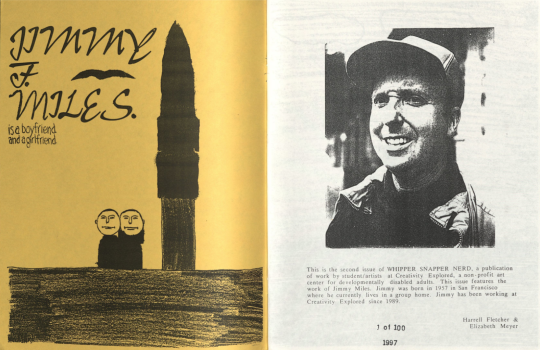

Images: Left, inside front cover of zine featuring the art and photo of Jimmy Miles. Right, inside front cover of zine featuring the art and photo of Michael Loggins.
A true highlight of each issue of Whipper Snapper Nerd are the interviews between each artist with either Fletcher or Meyer. Through these interviews readers get an insight into the interests, beliefs, and processes each artist has that translates into their work. Here the artists discuss their experience creating at Creativity Explored as well as any topic that should come up. The artists are honest, poignant, funny, and at times even blunt – it is fantastic. We learn that Barbara loves The Brady Bunch and cats. Jimmy doesn’t like questions, but he does love drawing planes. Michael loves hearing people laugh and has found the perfect jokes to tell his girlfriend Hope. John doesn’t like Linda Ronstadt or John Lennon but loves Curious George.
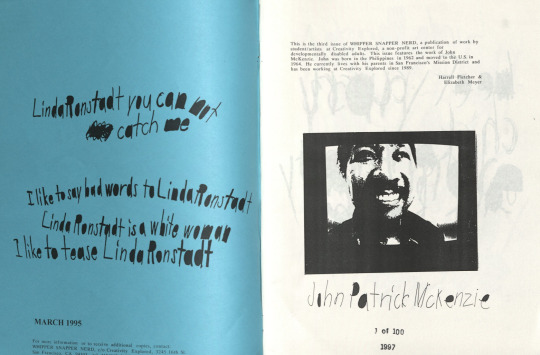
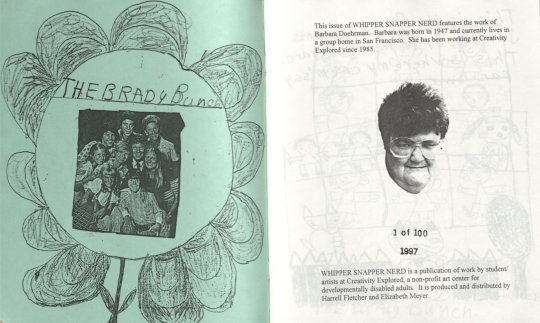
Images: Left, inside front cover of zine featuring art and photo of John Patrick McKenzie. Right, inside front cover of zine featuring art and photo of Barbara Doehrman.
Outlets like Creativity Explored are invaluable to a community which has been underrepresented and invalidated. Art is a universal language and allows freedom of expression and creativity that holds special importance for those with intellectual or developmental disabilities. Creating a similar space for disabled artists locally, Systems Unlimited, developed an arts center to promote radical inclusion through art in Eastern Iowa. Here, artists are supported and empowered to contribute to a creative community not only in Iowa but beyond.
Did you know?
Up to 1 in 4 (27%) adults in the United States have some type of disability
More than half of all adults with both cognitive and mobility disabilities reported mental destress
Engaging with art has been found to increase psychological health, boost self-esteem, reduce PTSD symptoms, and enhance communication skills.
At the University of Iowa, we also have services at the student level [UI Students for Disability Advocacy & Awareness (UISDAA)] and institutional level [Student Disability Services (SDS)].
-Kaylee S., Special Collections, Olson Graduate Assistant.
#uiowa#special collections#uiowaspecialcollections#voicesfromthestacks#creativityexplored#disability awareness#disability rights
16 notes
·
View notes
Text
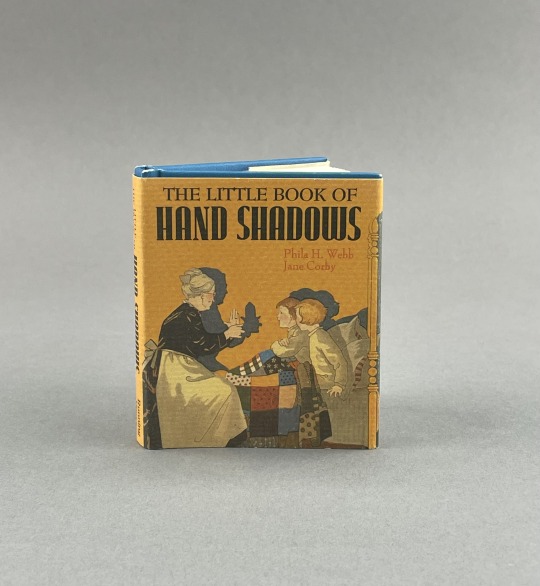
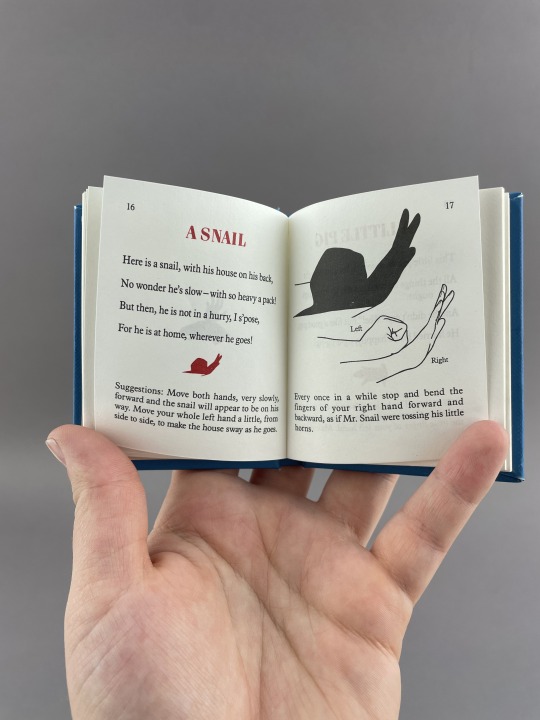
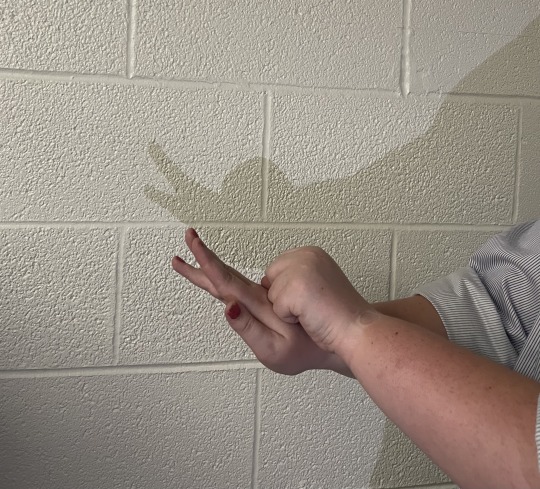
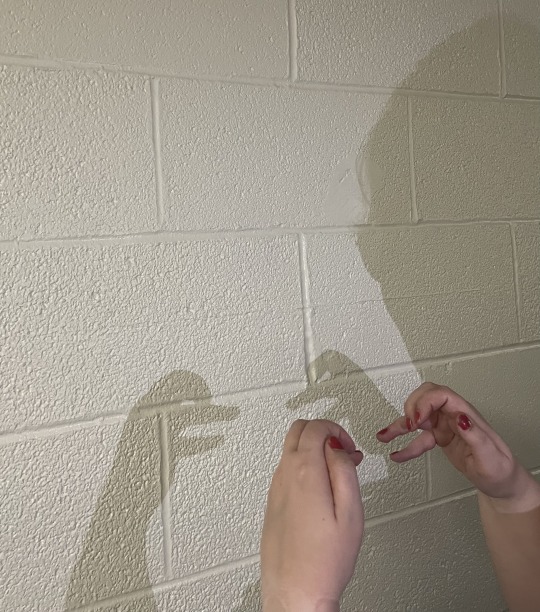
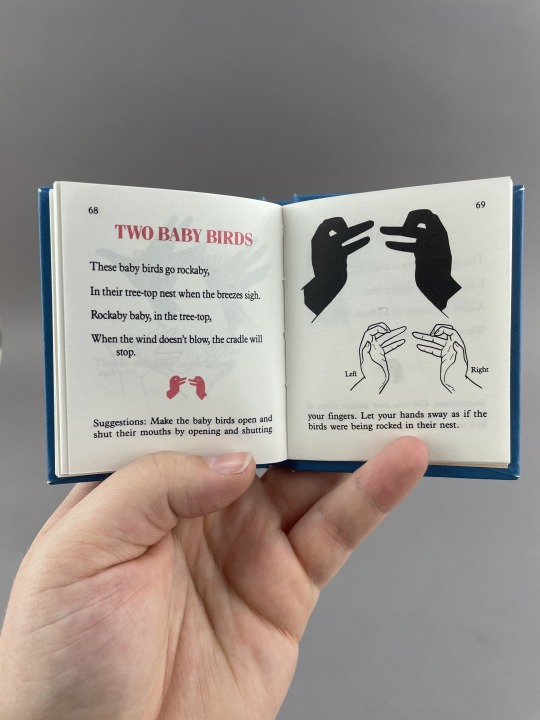
#MiniatureMonday
The Little Book of Hand Shadows
“Discover the timeless magic of hand shadows through this charming volume” - Dust Jacket
This little pocket-sized book, created and drawn by Phila H. Webb with verses by Jane Corby, is reprinted and adapted from the original “Shadowgraphs Anyone Can Make” from 1927. With the help of a bright light, a blank wall (or sheet as the book suggests), and two hands, various characters and creatures can be projected, solidifying the simple entertainment and joy of shadow puppetry.
According to Phila, some of the poses may take more practice to perfect, but there is “nothing hard about any of them”. To test this, I had a self-proclaimed shadow puppet enthusiast try out some of the poses, following the instructions from the text. How do you think they did?
-Kaylee S., Olson Graduate Assistant
-Sarah D.., Illustrious Hand Model
#uiowa#special collections#miniaturemonday#uiowaspecialcollections#miniature books#history#miniature monday#library#shadow puppets#puppetry#Phila H. Webb#Jane Corby#shadowgraphs
152 notes
·
View notes
Text
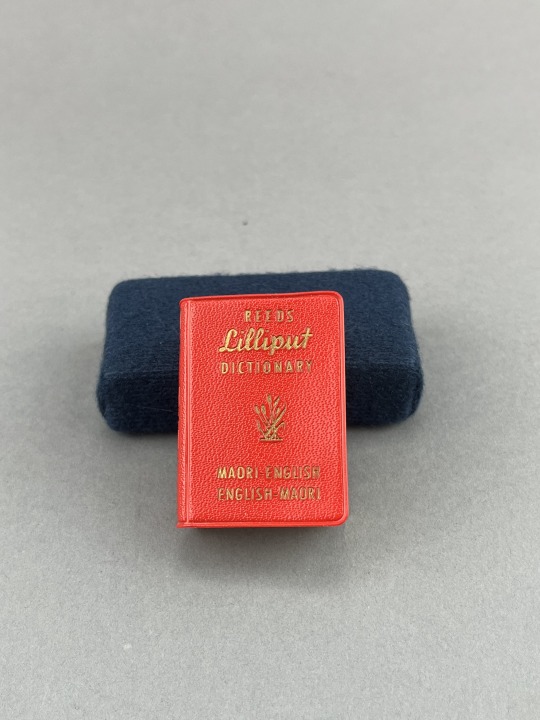
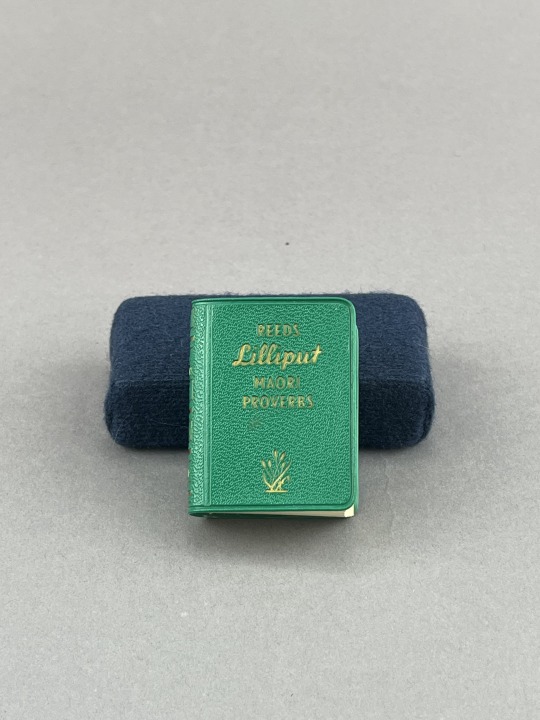

#MiniatureMonday
Happy Māori Language Week from Special Collections & Archives!
Te Wiki o te Reo Māori, Maori Language Week, is celebrated annually the week of September 14th to commemorate Te Wā Tuku Reo Māori, the Maori Language Moment, which stamps the presentation of the Maori Language Petition in New Zealand at 12 pm on September 14, 1972.
Te Reo Māori is the language of New Zealand's Indigenous Maori people. It is a part of the Austronesian language family and shares its roots with other island languages including Tahitian and Hawaiian. The celebration of Te Wiki is rooted deeply in efforts to revitalize the Māori language after years of the speaking and use of te reo was banned in schools. Today, te reo Māori is the official language of New Zealand, or Aotearoa as it is called by the Indigenous people. It has become increasingly used in New Zealand society, culture, and professional institutions. The Māori language has also become something of global interest, with the popularization of the language through its presence in music, film, television, and sports commentary.
In the United States, Polynesians as a whole make up less than half of a percent of the American population, with Māori people as one of the smallest migrant populations. Still, for those living abroad or interested in learning the language from afar, the language revitalization movement has certainly spread to the United States, along with its learning materials and resources.
There is a Māori proverb that reads ahakoa he iti he pounamu, "although it is small, it is greenstone." This refers to the importance of things small but precious, such as these miniatures!
The Reeds' Lilliput Māori dictionary and Reeds' Lilliput Māori proverbs live in Special Collections as part of the Smith Miniature Book Collection. These 5cm tall miniature books were published by A.W. Reed in the early 1960s, the dictionary in 1960 as part of a collection of miniature dictionaries made popular by other global publishers. The book of whakatauki, Māori proverbs, joined the mini-dictionary in 1964. Other language dictionaries include Spanish, French, and Romanian. Due to their size, it is likely that these books were made to entertain more so than educate. Still, they are certainly one of the many taonga, treasures, of Special Collections.
Te Wiki o te Reo Māori 2023 begins Monday, September 11, and concludes Sunday, September 17. Celebrate through songs, stories, conversations, or by learning some library-related Māori vocabulary! You can also visit the University of Iowa LibGuide on learning beginner's te reo Māori.
NGĀ KUPU WHARE PUKAPUKA LIBRARY VOCABULARY
pukapuka book
pūranga archive
whakaputunga collection
kaitiaki pukapuka librarian
wāhi tuku pukapuka reference desk
pānui to read
ako to learn
--From M Clark, Instruction GA
Reeds' proverbs (SMITH PL6465.Z77 .R44 1964) and Reeds' dictionary (SMITH PL6465.Z5 .R44 1960)
#uiowa#special collections#miniaturemonday#uiowaspecialcollections#rare books#library#maori culture#te reo maori#proverbs#new zealand
80 notes
·
View notes
Text
#MiniatureMonday #TinyTuesday!
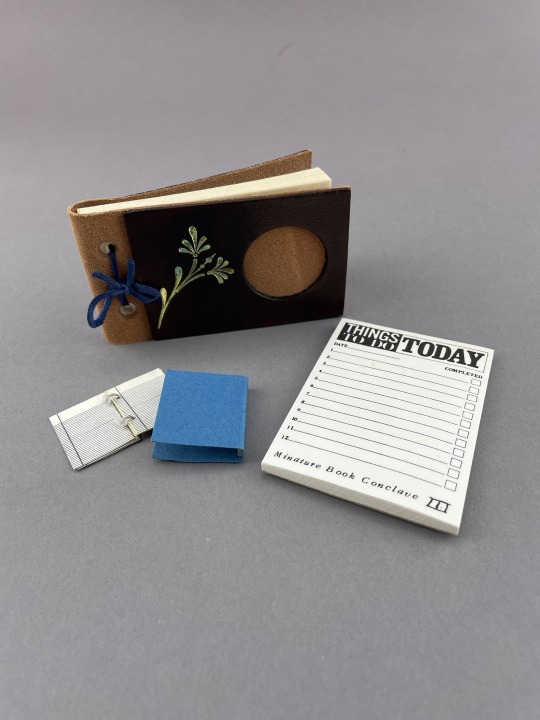
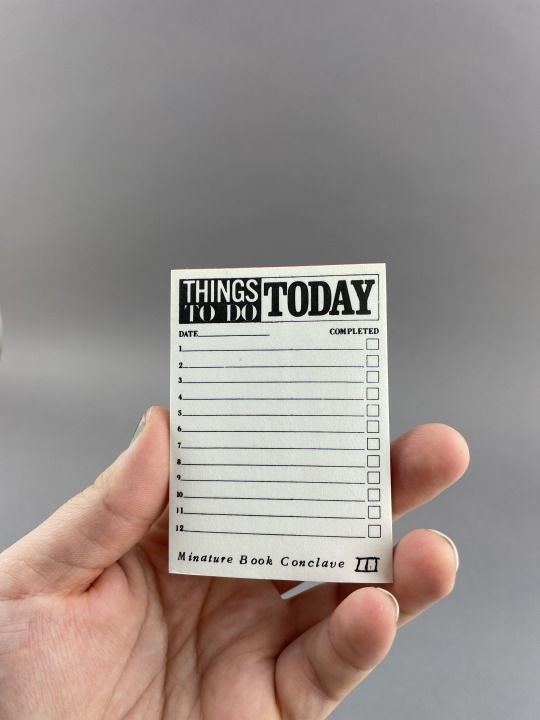
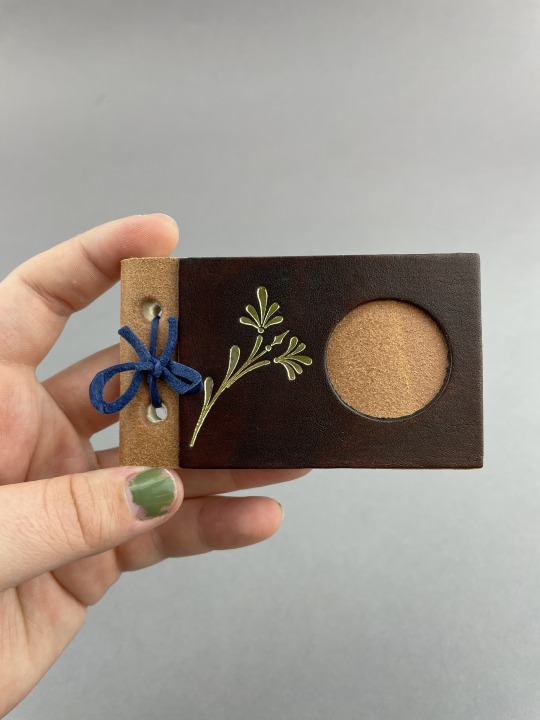
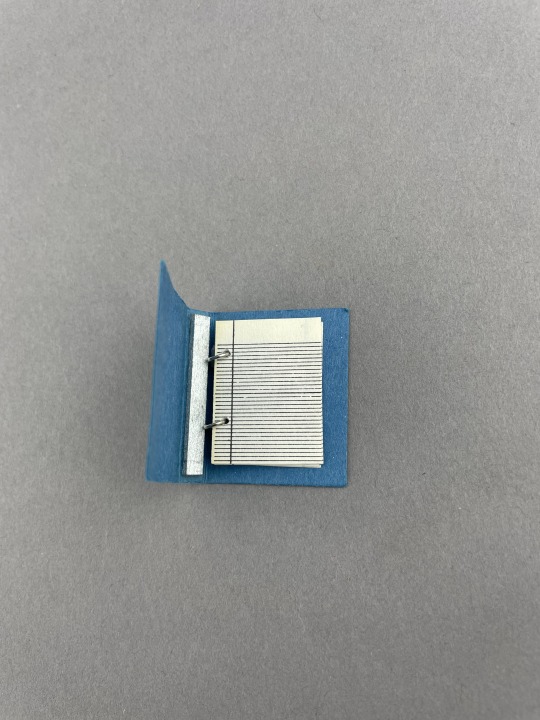
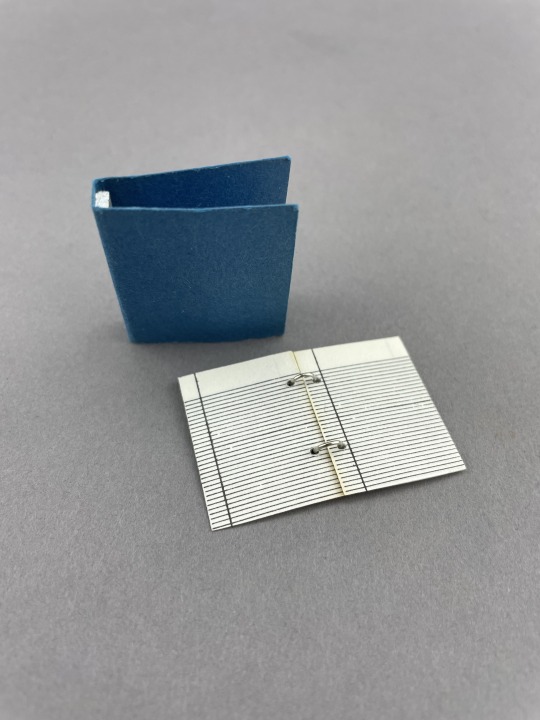
School Supplies
I think we all can agree that one of the best things about going back to school is new supplies! Whether it be notebooks, planners, pencils or pens, there is nothing quite like finding the perfect new things to carry you through the school year. Here are some minis that are perfect for the start of the new school year.
The first miniature is five leaves of blank notebook paper attached to metal rings, perfectly sized to fit inside the blank blue binder. The creator of this binder is not identified, but I like to think they made this little binder to send their mouse friend off to school with.
Next is a beautiful handmade notebook bound in soft brown leather with a gilt flower design stamped into the front cover. With lovely blank cream paper inside, this notebook is the perfect handheld size to carry around and jot down thoughts as they arise.
Originally made for the third Miniature Book Society Conclave held in LA in 1985, our third mini is a daily planner. With “Things to do today” printed largely at the top and a numbered checklist on the page, this would be an excellent way to keep your day organized!
-Kaylee S., Olson Graduate Assistant
Charlotte Smith Miniature Collection
TS1250 .T45 1985
TS1250 .M56
TS1250 .B53 1900z
#uiowa#miniaturemonday#history#library#special collections#miniature books#UiowaSpecialCollections#notebook#planner#artist books
72 notes
·
View notes
Text
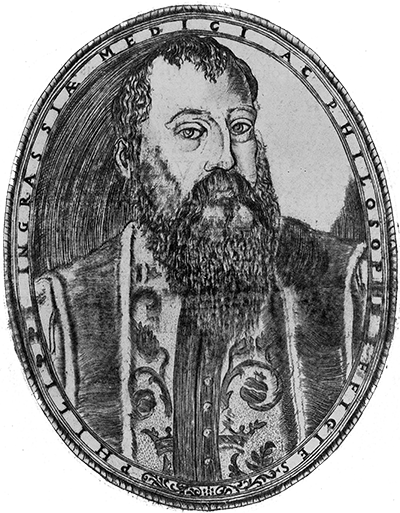
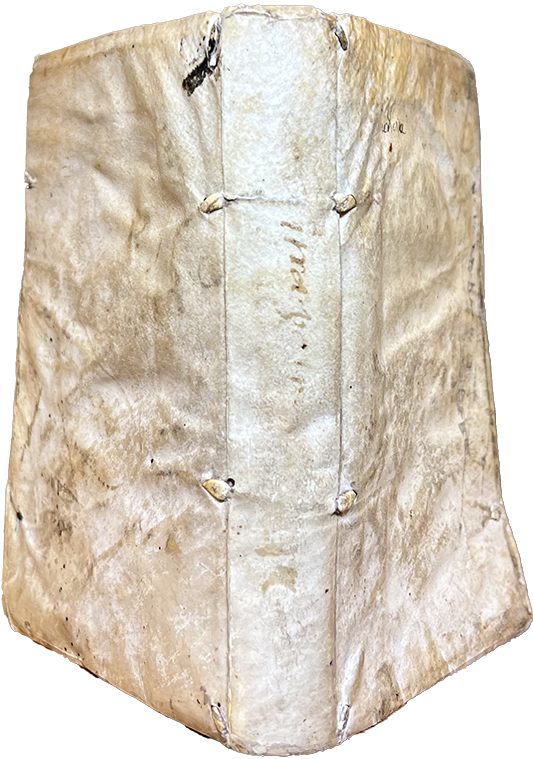
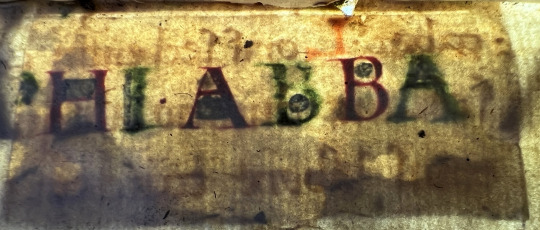

Special Guest Post from John Martin Rare Book Room
Hardin Library of Health Sciences
INGRASSIA, GIOVANNI FILIPPO (1510-1580). Iatrapologia: Quaestio, quae capitis vulneribus ac phrenitidi medicamenta conveniant [Defense of Medicine: Question regarding the medicinals convenient for head injuries and meningitis]. Printed in Venice by Giovanni Griffio, 1547. 16 cm tall.
This month's book was one of six John Martin Rare Book Room items selected to be scanned as part of the Iowa Initiative for Scientific Imaging and Conservation of Cultural Artifacts (IISICCA) project. Iatrapologia (Greek: "defense of medicine") by Giovanni Filippo Ingrassia (1510-1580) was selected for two reasons. One, with backlighting through the thin, limp vellum cover, we were able to determine it had small pieces of manuscript waste that included both green and red inks. Different inks show up at different energy levels in Computed Tomography (CT) scanners - or sometimes not at all. Finding a variety of inks helps to calibrate both types of scanners used in the project.
And two, it's just a darn cool book.
Ingrassia was an influential 16th-century Italian physician. He grew up in a well-educated family and received a classical education. He studied at the University of Padua, one of the most important western centers for the study of medicine and anatomy.
There, he learned from renowned intellectuals and physicians, such as Realdo Columbo, Bartolomeo Eustachi, Girolamo Fracastoro, and, of course, the Anatomaster® himself, Andreas Vesalius. Ingrassia would go on to make his own significant impact on not only anatomical medicine but also public health and hygiene, forensic medicine, and teratology (the study of abnormalities of physiological development).
After completing his studies in 1537, he became the personal physician to a minor Italian noble family in Palermo. Soon after, he became the professor of human anatomy at the University of Naples. It was during his time in Naples that he wrote Iatrapologia. Ostensibly a book about how to treat head wounds, it was also a critique of the current state of medicine and surgery - one of the subtitles, liber quo multa adversus barbaros medicos disputantur, translates as "a book in which many things are argued against the barbarian physicians."
In Iatrapologia and elsewhere, Ingrassia argued that medicine should be considered a less subjective discipline. Treatments should be verified, results checked, and useful diagnoses disseminated among physicians. He also thought that physicians and surgeons should be integrated into a single profession to prevent surgeries by "unqualified" people. Indeed, in Iatrapologia, he states rather dramatically,
"Oh, God, so much human suffering has been caused by the vainglory of contemporary doctors. Indeed, surgery has been abandoned to some inexperienced, empiric [i.e., quack] physicians, most of whom are not only lacking in dogma, but also in what relates to the Art." p. 252
Ingrassia was also a strong believer in continuing education, suggesting physicians should refresh their dissection skills every five years so as to avoid becoming "imperfect and ignorant physicians." If nothing else, Ingrassia demonstrated a natural skill with insults!
Ingrassia made significant contributions to the field of anatomy, particularly with bones and the skull. He is most well known for identifying a third small bone in the middle ear, which he called the "stapes." He also described differences between human and animal bones, breaking down parts of each bone to make identification easier.
Ingrassia was not only a physician and anatomist but also a pioneer in public health. He held various political positions, most notably Protomedicus (chief physician) of Sicily, and implemented measures to prevent the spread of diseases such as malaria and the plague. He emphasized the importance of preventive measures, such as isolating infected patients and cleaning objects to reduce the risk of transmission.
Overall, Giovanni Filippo Ingrassia was a remarkable physician and scientist who significantly contributed to our understanding of human anatomy and the practice of medicine.
Our copy of Iatrapologia is a delight to hold and leaf through and, as indicated, holds a few secrets inside. The limp vellum cover is soft but dried out enough that it has a bit of a rattle while opening. The cover image above shows discoloration from use and bits of writing here and there. The textblock is in excellent shape, the paper bright, and almost completely free of damage.
One interesting surprise is a piece of paper that has been pasted over the verso side of leaf A3 in an attempt to cover up a printer's error (a repeated page from elsewhere in the book). At some point, someone made a concerted effort to remove the paper to see what was underneath. Whoever glued it on, though, made sure the vandal couldn't remove much!
Other surprises can be seen in the images above. The images show close-ups of the text visible with backlighting. In one image, green and red inks are still vibrant and really jump out. The IISICCA group estimates the date of the manuscript to be roughly the 10th or 11th century and suspects the complete word is some form of "archiabbas" (chief abbot).
Another image shows a small scrap where the photo is repeated several times. Different photo filters were applied in an attempt to make the text more legible.
Contact me to take a look at this book or any others from this or past newsletters: [email protected]
#medicine#medical history#rare books#library#special collections#history#uiowa#Giovanni Filippo Ingrassia#public health
76 notes
·
View notes
Text



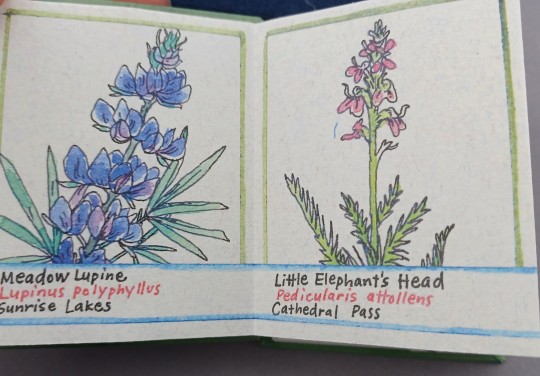


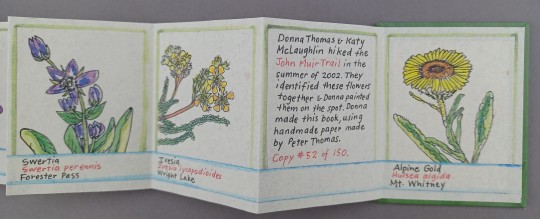
#MiniatureMonday
Wildflowers of the John Muir Trail
This the finale to our little summer series focusing on a small fraction of the lovely artists books by Peter and Donna Thomas.
This is also my last Miniature Monday post, as I am moving to my new job after graduating this spring. It has been great sharing all these lovely minis, and I am looking forward to seeing those that are posted in the future! --Diane
This wonderful collection of illustrations features plants painted by Donna Thomas while she was hiking the John Muir Trail with Katy McLaughlin.
"They identified these flowers together & Donna painted them on the spot. Donna made this book, using handmade paper made by Peter Thomas. "--Colophon.
Continuous accordion folded strip made from five sections folded to form forty leaves.
Peter and Donna Thomas are "book artists from Santa Cruz, CA. They work both collaboratively and individually; letterpress printing, hand-lettering and illustrating texts, making paper, and hand binding both fine press and artists’ books." They have made over 100 limited edition books, often with Peter making the paper, and Donna doing the illustrations.
Check out more of Donna and Peter's books at Uiowa here.
--Diane R., Special Collections Graduate Student

#uiowa#UIowa Special Collections#Peter&DonnaThomas#John Muir#Plants#Botanical illustration#Paintings#Hiking#John Muir Trail#Handmade paper#Wildflowers of the John Muir Trail#Wildflowers#rare books#miniaturemonday
223 notes
·
View notes